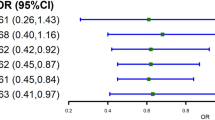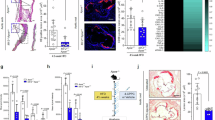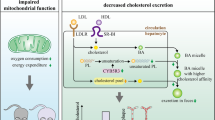Abstract
Fibrates, peroxisome proliferator−activated receptor α agonists, are widely used as lipid-lowering agents with anti-atherogenic activity. However, conflicting results have been reported with regard to their pharmacological effects on plasma lipoprotein profiles as well as on atherosclerosis in animal models. Furthermore, the anti-atherogenic effects of bezafibrate, one of the most commonly used fibrates, in animal models have not been reported. In the present study, we investigated the effects of bezafibrate on lipoprotein profiles as well as on atherosclerosis in low-density lipoprotein receptor knockout (LDLR−/−) mice fed an atherogenic diet for 8 weeks. Bezafibrate decreased plasma levels of both cholesterol and triglycerides (TG), while increasing plasma levels of high-density lipoprotein-cholesterol (HDL-C). Since hepatic TG production was significantly reduced in the bezafibrate-treated mice lacking LDLR, the plasma lipid−lowering effects of bezafibrate might be primarily mediated by the suppression of hepatic production of apolipoprotein-B−containing lipoproteins. In parallel with the reduced ratio of non-HDL-C to HDL-C, bezafibrate suppressed fatty streak lesions in the aortic sinus by 51%. To determine whether or not bezafibrate directly alters the expression of genes relevant to atherosclerosis, we measured mRNA expression levels of three genes in the aorta by real-time PCR: ATP-binding cassette transporter A1, lipoprotein lipase, and monocyte chemoattractant protein-1. The results showed that there were no differences in the expression of these genes between mice treated with bezafibrate and those not. In conclusion, bezafibrate inhibits atherosclerosis in LDLR−/− mice primarily by decreasing the ratio of non-HDL-C to HDL-C.
Similar content being viewed by others
Article PDF
References
Staels B, Dallongeville J, Auwerx J, Schoonjans K, Leitersdorf E, Fruchart JC : Mechanism of action of fibrates on lipid and lipoprotein metabolism. Circulation 1998; 98: 2088–2093.
Willson TM, Brown PJ, Sternbach DD, Henke BR : The PPARs: from orphan receptors to drug discovery. J Med Chem 2000; 43: 527–550.
Shepherd J : Mechanism of action of fibrates. Postgrad Med J 1993; 69 ( Suppl 1): S34–S41.
Caslake MJ, Packard CJ, Gaw A, et al: Fenofibrate and LDL metabolic heterogeneity in hypercholesterolemia. Arterioscler Thromb 1993; 13: 702–711.
Schoonjans K, Peinado-Onsurbe J, Lefebvre AM, et al: PPARalpha and PPARgamma activators direct a distinct tissue-specific transcriptional response via a PPRE in the lipoprotein lipase gene. EMBO J 1996; 15: 5336–5348.
Heller F, Harvengt C : Effects of clofibrate, bezafibrate, fenofibrate and probucol on plasma lipolytic enzymes in normolipaemic subjects. Eur J Clin Pharmacol 1983; 25: 57–63.
Staels B, Auwerx J : Perturbation of developmental gene expression in rat liver by fibric acid derivatives: lipoprotein lipase and alpha-fetoprotein as models. Development 1992; 115: 1035–1043.
Staels B, Vu-Dac N, Kosykh VA, et al: Fibrates downregulate apolipoprotein C-III expression independent of induction of peroxisomal acyl coenzyme A oxidase. A potential mechanism for the hypolipidemic action of fibrates. J Clin Invest 1995; 95: 705–712.
Wang CS, McConathy WJ, Kloer HU, Alaupovic P : Modulation of lipoprotein lipase activity by apolipoproteins. Effect of apolipoprotein C-III. J Clin Invest 1985; 75: 384–390.
Torra IP, Chinetti G, Duval C, Fruchart JC, Staels B : Peroxisome proliferator−activated receptors: from transcriptional control to clinical practice. Curr Opin Lipidol 2001; 12: 245–254.
Staels B, Auwerx J : Regulation of apo A-I gene expression by fibrates. Atherosclerosis 1998; 137 ( Suppl): S19–S23.
Berthou L, Saladin R, Yaqoob P, et al: Regulation of rat liver apolipoprotein A-I, apolipoprotein A-II and acyl-coenzyme A oxidase gene expression by fibrates and dietary fatty acids. Eur J Biochem 1995; 232: 179–187.
Marx N, Sukhova GK, Collins T, Libby P, Plutzky J : PPARalpha activators inhibit cytokine-induced vascular cell adhesion molecule-1 expression in human endothelial cells. Circulation 1999; 99: 3125–3131.
Shu H, Wong B, Zhou G, et al: Activation of PPARalpha or gamma reduces secretion of matrix metalloproteinase 9 but not interleukin 8 from human monocytic THP-1 cells. Biochem Biophys Res Commun 2000; 267: 345–349.
Neve BP, Corseaux D, Chinetti G, et al: PPARalpha agonists inhibit tissue factor expression in human monocytes and macrophages. Circulation 2001; 103: 207–212.
Chinetti G, Griglio S, Antonucci M, et al: Activation of proliferator-activated receptors alpha and gamma induces apoptosis of human monocyte-derived macrophages. J Biol Chem 1998; 273: 25573–25580.
Duez H, Chao YS, Hernandez M, et al: Reduction of atherosclerosis by the peroxisome proliferator−activated receptor alpha agonist fenofibrate in mice. J Biol Chem 2002; 277: 48051–48057.
Fu T, Kashireddy P, Borensztajn J : The peroxisome-proliferator−activated receptor alpha agonist ciprofibrate severely aggravates hypercholesterolaemia and accelerates the development of atherosclerosis in mice lacking apolipoprotein E. Biochem J 2003; 373: 941–947.
Fu T, Mukhopadhyay D, Davidson NO, Borensztajn J : The peroxisome proliferator−activated receptor alpha (PPARalpha) agonist ciprofibrate inhibits apolipoprotein B mRNA editing in low density lipoprotein receptor−deficient mice: effects on plasma lipoproteins and the development of atherosclerotic lesions. J Biol Chem 2004; 279: 28662–28669.
Tordjman K, Bernal-Mizrachi C, Zemany L, et al: PPARalpha deficiency reduces insulin resistance and atherosclerosis in apoE-null mice. J Clin Invest 2001; 107: 1025–1034.
Ericsson CG, Hamsten A, Nilsson J, Grip L, Svane B, de Faire U : Angiographic assessment of effects of bezafibrate on progression of coronary artery disease in young male postinfarction patients. Lancet 1996; 347: 849–853.
Group TBS: Secondary prevention by raising HDL cholesterol and reducing triglycerides in patients with coronary artery disease: the Bezafibrate Infarction Prevention (BIP) study. Circulation 2000; 102: 21–27.
Ishibashi S, Brown MS, Goldstein JL, Gerard RD, Hammer RE, Herz J : Hypercholesterolemia in low density lipoprotein receptor knockout mice and its reversal by adenovirus-mediated gene delivery. J Clin Invest 1993; 92: 883–893.
Paigen B, Morrow A, Brandon C, Mitchell D, Holmes P : Variation in susceptibility to atherosclerosis among inbred strains of mice. Atherosclerosis 1985; 57: 65–73.
Paigen B, Morrow A, Holmes PA, Mitchell D, Williams RA : Quantitative assessment of atherosclerotic lesions in mice. Atherosclerosis 1987; 68: 231–240.
Yagyu H, Kitamine T, Osuga J, et al: Absence of ACAT-1 attenuates atherosclerosis but causes dry eye and cutaneous xanthomatosis in mice with congenital hyperlipidemia. J Biol Chem 2000; 275: 21324–21330.
Usui S, Hara Y, Hosaki S, Okazaki M : A new on-line dual enzymatic method for simultaneous quantification of cholesterol and triglycerides in lipoproteins by HPLC. J Lipid Res 2002; 43: 805–814.
Kako Y, Huang LS, Yang J, Katopodis T, Ramakrishnan R, Goldberg IJ : Streptozotocin-induced diabetes in human apolipoprotein B transgenic mice. Effects on lipoproteins and atherosclerosis. J Lipid Res 1999; 40: 2185–2194.
van Vlijmen BJ, Rohlmann A, Page ST, et al: An extrahepatic receptor−associated protein−sensitive mechanism is involved in the metabolism of triglyceride-rich lipoproteins. J Biol Chem 1999; 274: 35219–35226.
Livak KJ, Schmittgen TD : Analysis of relative gene expression data using real-time quantitative PCR and the 2(−Delta Delta C(T)) Method. Methods 2001; 25: 402–408.
Frick MH, Elo O, Haapa K, et al: Helsinki Heart Study: primary-prevention trial with gemfibrozil in middle-aged men with dyslipidemia. Safety of treatment, changes in risk factors, and incidence of coronary heart disease. N Engl J Med 1987; 317: 1237–1245.
Rubins HB, Robins SJ, Collins D, et al: Gemfibrozil for the secondary prevention of coronary heart disease in men with low levels of high-density lipoprotein cholesterol. Veterans Affairs High-Density Lipoprotein Cholesterol Intervention Trial Study Group. N Engl J Med 1999; 341: 410–418.
Keech A, Simes RJ, Barter P, et al: Effects of long-term fenofibrate therapy on cardiovascular events in 9795 people with type 2 diabetes mellitus (the FIELD study): randomised controlled trial. Lancet 2005; 366: 1849–1861.
Li L, Beauchamp MC, Renier G : Peroxisome proliferator−activated receptor alpha and gamma agonists upregulate human macrophage lipoprotein lipase expression. Atherosclerosis 2002; 165: 101–110.
Peters JM, Hennuyer N, Staels B, et al: Alterations in lipoprotein metabolism in peroxisome proliferator−activated receptor alpha-deficient mice. J Biol Chem 1997; 272: 27307–27312.
Berger J, Moller DE : The mechanisms of action of PPARs. Annu Rev Med 2002; 53: 409–435.
Shimada M, Ishibashi S, Inaba T, et al: Suppression of diet-induced atherosclerosis in low density lipoprotein receptor knockout mice overexpressing lipoprotein lipase. Proc Natl Acad Sci U S A 1996; 93: 7242–7246.
Yamauchi T, Kamon J, Waki H, et al: Globular adiponectin protected ob/ob mice from diabetes and ApoE-deficient mice from atherosclerosis. J Biol Chem 2003; 278: 2461–2468.
Okamoto Y, Kihara S, Ouchi N, et al: Adiponectin reduces atherosclerosis in apolipoprotein E−deficient mice. Circulation 2002; 106: 2767–2770.
Guerre-Millo M, Gervois P, Raspe E, et al: Peroxisome proliferator−activated receptor alpha activators improve insulin sensitivity and reduce adiposity. J Biol Chem 2000; 275: 16638–16642.
Kim JI, Tsujino T, Fujioka Y, Saito K, Yokoyama M : Bezafibrate improves hypertension and insulin sensitivity in humans. Hypertens Res 2003; 26: 307–313.
Tenenbaum A, Motro M, Fisman EZ, et al: Peroxisome proliferator−activated receptor ligand bezafibrate for prevention of type 2 diabetes mellitus in patients with coronary artery disease. Circulation 2004; 109: 2197–2202.
Chinetti G, Lestavel S, Bocher V, et al: PPAR-alpha and PPAR-gamma activators induce cholesterol removal from human macrophage foam cells through stimulation of the ABCA1 pathway. Nat Med 2001; 7: 53–58.
Chinetti G, Fruchart JC, Staels B : Peroxisome proliferator−activated receptors: new targets for the pharmacological modulation of macrophage gene expression and function. Curr Opin Lipidol 2003; 14: 459–468.
Author information
Authors and Affiliations
Corresponding author
Rights and permissions
About this article
Cite this article
Inaba, T., Yagyu, H., Itabashi, N. et al. Cholesterol Reduction and Atherosclerosis Inhibition by Bezafibrate in Low-Density Lipoprotein Receptor Knockout Mice. Hypertens Res 31, 999–1005 (2008). https://doi.org/10.1291/hypres.31.999
Received:
Accepted:
Issue date:
DOI: https://doi.org/10.1291/hypres.31.999



